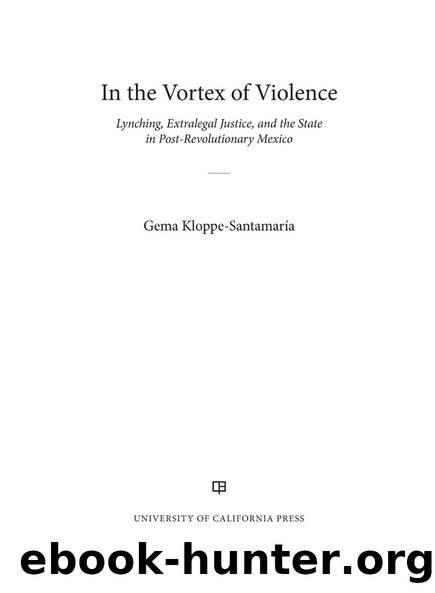In the Vortex of Violence by Gema Kloppe-Santamaría

Author:Gema Kloppe-Santamaría [Kloppe-Santamaría, Gema]
Language: eng
Format: epub
ISBN: 9780520344037
Google: YrPrDwAAQBAJ
Publisher: Univ of California Press
Published: 2020-01-15T01:11:34+00:00
Appendix
Definitions, Methods, and Sources for the Study of Lynching in Post-Revolutionary Mexico
The definition of lynching advanced by this book (see introduction) reflects some of the minimum criteria I used to determine which cases I would analyze as lynching, independently of the name given by contemporaries to describe this practice. In security reports, press articles, and letters of complaint, contemporaries referred to most incidents of lynching by the Spanish word linchamiento. Throughout the 1930s, several cases were described, using the English spelling, as lynchamientos, signaling the importance of the U.S. trajectory of lynching for Mexicoâs understanding of this practice.1 Nevertheless, other events that matched the criteria used in my research to identify cases of lynching were described under different names, such as justicia por mano propia (self-help justice), zafarrancho (disarray), tumulto (tumult), or even crimen salvaje (savage crime). These expressions point to the diverse opinions or sentiments provoked by mob violence among a given public or readership. The incidents described by the word linchamiento involved cases justified by the press as a means to attain justice as well as cases portrayed as expressions of the alleged savagery, backwardness, or ignorance of those who perpetrated them. In other words, the use of the word linchamiento in itself implied neither support nor rejection of this practice.
In order to consider an event a lynching, I decided that the number of perpetrators had to outnumber the number of victims by a ratio of 3 to 1 and violence had to be unilateral, meaning that victims did not reciprocate or respond to a given attack.2 Also, attacks had to be perpetrated publicly, in plain sight and in front of witnesses. Furthermore, the incident had to involve an attempt to punish a behavior that offended a community and not just one individual.3 Although most cases of lynching involved the participation of ordinary citizens rather than state actors or public officials, periodicals and other primary sources also referred to collective killings perpetrated by and with the support of state actors as âlinchamientos,â particularly when such cases involved the use of public, cruel, and overt forms of torment. This book recognizes and incorporates this seeming elasticity of the term âlynchingâ as it allows me to highlight the stateâs complicity in the perpetration of lynching as well as to trace the complex connections between state and non-state forms of violence in Mexico.4
The latter aspect of this definition demands clarification of yet another term, âcommunity.â I use the term âcommunityâ to refer to individuals or groups of individuals that, beyond sharing a locality, neighborhood, or town, were united by a hegemonic cultural, political, or religious identity. A community, then, includes villagers who interacted with considerable regularity in their everyday lives, as well as urban dwellers who, despite their limited interaction, shared a common understanding of what constituted criminal or immoral conduct.5 Far from being conflict-free or static, a community is thus understood as a dynamic and internally divided entity whose political, religious, and social boundaries are constantly being negotiated or redefined.
Download
This site does not store any files on its server. We only index and link to content provided by other sites. Please contact the content providers to delete copyright contents if any and email us, we'll remove relevant links or contents immediately.
| Canada | Caribbean & West Indies |
| Central America | Greenland |
| Mexico | Native American |
| South America | United States |
Cat's cradle by Kurt Vonnegut(15192)
Pimp by Iceberg Slim(14401)
4 3 2 1: A Novel by Paul Auster(12290)
Underground: A Human History of the Worlds Beneath Our Feet by Will Hunt(12027)
The Radium Girls by Kate Moore(11935)
Wiseguy by Nicholas Pileggi(5675)
Perfect Rhythm by Jae(5328)
American History Stories, Volume III (Yesterday's Classics) by Pratt Mara L(5259)
The Fire Next Time by James Baldwin(5253)
Paper Towns by Green John(5094)
Pale Blue Dot by Carl Sagan(4917)
A Higher Loyalty: Truth, Lies, and Leadership by James Comey(4851)
The Mayflower and the Pilgrims' New World by Nathaniel Philbrick(4430)
The Doomsday Machine by Daniel Ellsberg(4421)
Killers of the Flower Moon: The Osage Murders and the Birth of the FBI by David Grann(4387)
The Sympathizer by Viet Thanh Nguyen(4309)
Too Much and Not the Mood by Durga Chew-Bose(4278)
The Borden Murders by Sarah Miller(4252)
Sticky Fingers by Joe Hagan(4106)
